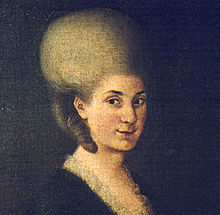Maria Anna Mozart


Maria Anna Walburga Ignatia Mozart (* July 30, 1751 in Salzburg ; † October 29, 1829 ibid), later Maria Anna Freifrau von Berchtold zu Sonnenburg, called "Nannerl" in family and friends, was the older sister of Wolfgang Amadeus Mozart and the Daughter of Anna Maria (née Pertl) and Leopold Mozart .
Life
In her youth she performed as a pianist in concerts all over Europe with her brother Wolfgang Amadeus Mozart and at the age of eleven she played the most difficult sonatas and concertos on the piano. Although, like her brother, she had an extraordinary musical talent, she never stepped out of his shadow. This was due to the support of her father, who focused completely on Wolfgang after Nannerl reached marriageable age and thus had other goals to pursue according to the view of the time. Thus, only small musical composition exercises have come down to us from her, but no compositions of her own, as in later years she concentrated on her family and her work as a piano teacher.
After her father a marriage with the chamberlain had not agreed Franz Armand d'Ippold, she went one on 23 August 1784 marriage with 15-year-old Johann Baptist Reichsfreiherr a Berchtold von Sonnenburg (1736-1801). He was a successor in office of her maternal grandfather, and that is why she lived with him in St. Gilgen in his official apartment, the house where her mother was born. Her husband brought in five children from two marriages, and she bore three children. After the death of her husband in 1801, she returned to Salzburg with her two children, Leopold and Jeanette, who were still alive, where she was a very valued piano teacher.
At the age of 74 she went blind, whereupon her source of income dried up, "because in the emergency of her blindness she could no longer give instructions".
Maria Anna's diaries, letters and memories were and are valuable sources for Mozart research. They were in 1829, with the reason for the visit of the London couple Mary (Maria Sibylla) and Vincent Novello ( A Mozart Pilgrimage - A pilgrimage to Mozart ) in their Salzburg home. Before that, the English had read from the then published Mozart literature of the child prodigy trips she described. The couple had also found out that Maria Anna was no longer doing so well, so they brought her a gift of money donated by English music lovers. She died that same year and was buried at her own request in the Petersfriedhof in Salzburg .
Eva Rieger summed up Nannerl's role as the sister of the genius in her biography:
“If you take into account that she was an extraordinarily talented musician, then there is a painful discrepancy. Possible skills were not even awakened, let alone cultivated and strengthened. "
See also
literature
- Constantin von Wurzbach : Berchtold, Maria Anna Reichsfreiin von . In: Biographisches Lexikon des Kaiserthums Oesterreich . 1st part. University book printing company L. C. Zamarski (formerly JP Sollinger), Vienna 1856, p. 290 f. ( Digitized version ).
- Constantin von Wurzbach : Mozart, Maria Anna . In: Biographisches Lexikon des Kaiserthums Oesterreich . 19th part. Imperial and Royal Court and State Printing Office, Vienna 1868, p. 297 ( digitized version ).
- Eva Rieger : Nannerl Mozart. Life of an Artist in the 18th Century . Frankfurt / M. 1990. Revised edition 2005. Swedish translation 1992.
- Eva Neumayr (ed.): Maria Anna Mozart. Facets of an artist. Vienna: Hollitzer 2019. ISBN 978-3-99012-561-8
Web links
- Melanie Unseld: Article “Maria Anna Mozart” . In: MUGI. Music education and gender research: Lexicon and multimedia presentations , ed. by Beatrix Borchard and Nina Noeske, University of Music and Theater Hamburg, 2003ff. As of May 29, 2018
- Freia Hoffmann: Article on Anna Mozart . In: European female instrumentalists of the 18th and 19th centuries . 2009. Online encyclopedia of the Sophie Drinker Institute, ed. by Freia Hoffmann
- Literature by and about Maria Anna Mozart in the catalog of the German National Library
- Biography, literature & sources on Nannerl Mozart on FemBio.org of the Institute for Women's Biography Research
- Maria Anna Mozart in the Bavarian Musicians' Lexicon Online (BMLO)
- The prevented pianist career by Nannerl Mozart Traunsteiner Tagblatt, 30/2001
- Entry on Maria Anna Mozart in the Austria Forum (in the AEIOU Austria Lexicon )
- Mozarthaus in St. Gilgen on the Wolfgangsee
- Michael Malkiewicz: Salzburg Journal - Nannerl Mozart and Erich Schenk
Individual references and comments
- ^ Baptismal register - TFBIX / 1 | Salzburg Cathedral Parish | Salzburg, rk. Diocese | Austria | Matricula Online. Retrieved November 1, 2017 .
- ↑ Death book - STB1 | Salzburg-St. Blaise | Salzburg, rk. Diocese | Austria | Matricula Online. Retrieved November 1, 2017 .
- ↑ Wedding book - TRBII | St. Gilgen | Salzburg, rk. Diocese | Austria | Matricula Online. Retrieved November 1, 2017 .
- ^ Eva Rieger: Nannerl Mozart , 3rd ed. 1991, p. 274.
- ^ Eva Rieger: Nannerl Mozart , 3rd ed. 1991. Description of the visit, pp. 272 and 273.
- ^ Eva Rieger: Nannerl Mozart . 3rd edition 1991, p. 73.
| personal data | |
|---|---|
| SURNAME | Mozart, Maria Anna |
| ALTERNATIVE NAMES | Mozart, Maria Anna Walburga Ignatia (full name at birth); Mozart, Nannerl |
| BRIEF DESCRIPTION | Sister of Wolfgang Amadeus Mozart, composer, child prodigy |
| BIRTH DATE | July 30, 1751 |
| PLACE OF BIRTH | Salzburg |
| DATE OF DEATH | October 29, 1829 |
| PLACE OF DEATH | Salzburg |

